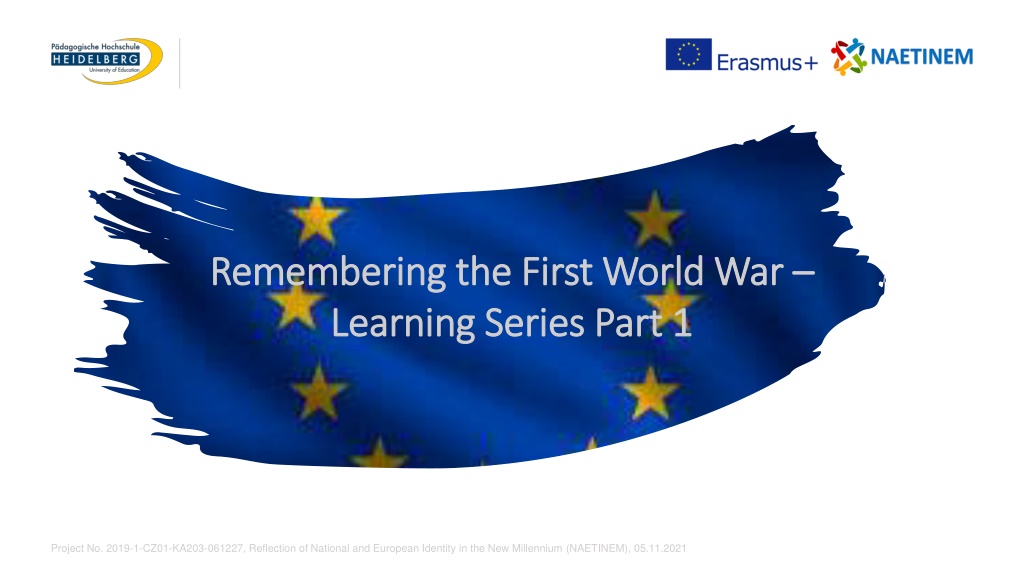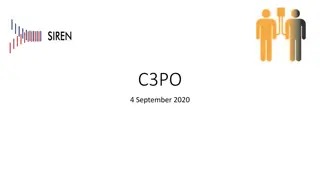Exploring Memory Sites of the First World War
Delve into the remembrance of the First World War through the lens of memory sites and cultures in Europe. Discover the significance of places of remembrance and analyze their impact on collective memory. Reflect on the advantages and disadvantages of these sites for young people, and consider ways to enhance their appeal for educational purposes.
Download Presentation

Please find below an Image/Link to download the presentation.
The content on the website is provided AS IS for your information and personal use only. It may not be sold, licensed, or shared on other websites without obtaining consent from the author. Download presentation by click this link. If you encounter any issues during the download, it is possible that the publisher has removed the file from their server.
E N D
Presentation Transcript
Remembering Remembering the Learning Series Part 1 Learning Series Part 1 the First World War First World War Project No. 2019-1-CZ01-KA203-061227, Reflection of National and European Identity in the New Millennium (NAETINEM), 05.11.2021
1. 1. Introduction Introduction: : a) Together with your group, think about how the First World War is remembered today in your area or country, or where you encounter the First World War outside of school. Create a padlet together to get an overview. You can also add short videos or photos. Tip: You can create the padlet with https://de.padlet.com/.
2. Basics: 2. Basics: a)In addition to (modern) media such as films, places of remembrance are also important. Read the short section on places of remembrance (M1). Then look at the pictures (M2) on the following slides.
M1 M1 Cultures and places of memory in Europe Place can amount to the unification of all the memories of a group, according to Maurice Halbwachs: in historical turmoil, cities and their stones act as fixed points. And so special 'places' can be media of remembrance alongside non- fiction books, films, monuments, commemorations and memorial days. French historian Pierre Nora coined the term 'place of memory' (Les lieux de m moire) in 1984, which goes beyond this. Both terms are important for the study of memory sites and cultures. Nora refers to 'places' that are important for the formation of a political identity and further defines 'places of memory' as media of the collective memory of a community. According to Nora, they include memorials, museums, memorials, but also events, commemorations, moments of silence, and texts. 'Places of memory' are both symbolic and functional and manifest in space and time. The collective memory of a group is crystallized in such a 'place': the symbolic power of this 'place' has an identity-forming function.
M2 M2 Memorial to the Battle of Verdun, France Historisches Museum Hannover, Exhibition: Heimatfront Hannover Former battlefield near Verdun, France
2. Basics: 2. Basics: b)What are the advantages and disadvantages of the places of remembrance for young people? Divide the places of remembrance among yourselves and create a pro/contra list to present to your group members. c) Then write an e-mail to the person responsible for a place of remembrance in which you state your opinion and give tips on how a place of remembrance could be made (even) more attractive for school classes.
3. Elaboration: 3. Elaboration: Of course, wars are not pleasant memories. In this context, the question often arises whether one should remember them at all or whether it would not be better to forget what happened. a) Take a written position on the following statement made by the student Hannah. Write an e-mail explaining your opinion to Hannah. Do you share Hannah's opinion or not? Try to justify your statement with 2-3 examples. "It is better to forget wars, because the constant memory of them, can harm a society."























